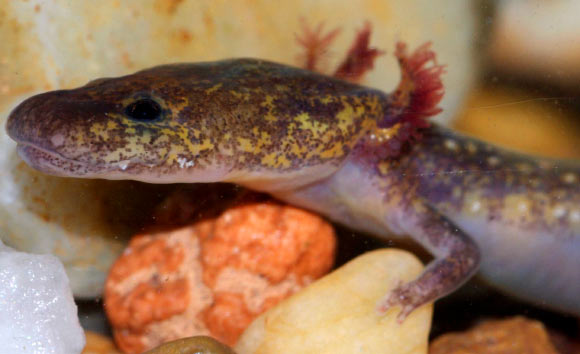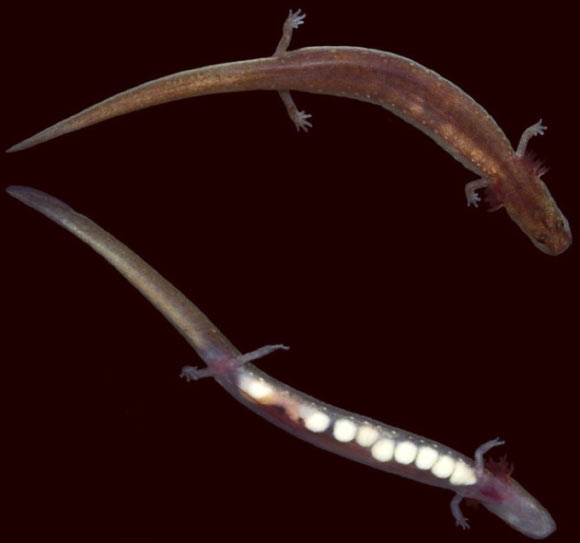Herpetologists from the University of Tulsa and Arkansas Game and Fish Commission have described a new species of salamander from Lake Catherine State Park, Hot Spring County, Arkansas.

Ouachita Streambed Salamander (Eurycea subfluvicola). Image credit: Mike Steffen / University of Tulsa.
In May 2011, the team caught a single specimen of the new species while collecting larvae of a more common species, the Many-ribbed Salamander (Eurycea multiplicata).
“DNA analyses later revealed that this specimen was most closely related to, but still highly divergent from the many-ribbed salamander, and all other described salamanders,” explained Dr Ronald M. Bonett from the University of Tulsa, who is the senior author of the paper published in the journal Zootaxa (full paper in .pdf).
The new salamander species has been scientifically named Eurycea subfluvicola. The common name is the Ouachita Streambed Salamander.
“The name subfluvicoa (dwells below the streambed) describes the species’ behavior of retreating below the streambed when surface waters dry,” Dr Bonett said.
“In fact, due to severe drought conditions in the area, it was almost two years before additional specimens were located.”
With these additional specimens, Tulsa University PhD student Michael Steffen, fellow gradate student Andrea Blair, and Dr Bonett, showed that not only is the new species genetically distinct, but differs from the Many-ribbed Salamander in their shape and life history traits.
“The Ouachita Streambed Salamander is paedomorphic, meaning that it retains aquatic larval juvenile characteristics into adulthood, and therefore it superficially resembles the aquatic larvae of related species.”
The Ouachita Streambed Salamander measures about 35-45 mm in males and 31-48 mm in females.
“The dorsum of the salamander is primarily uniform amber/yellow background color, pigmented with numerous dark brown melanophores, which create irregularly shaped blotches throughout the dorsum and flanks,” Dr Bonett and his colleagues wrote in the Zootaxa paper.
“In most individuals irregularly spaced spots are formed by the absence of melanophores along the dorsolateral region of the trunk, possibly indicative of the lateral line. The semi-transparent venter is unpigmented, except for a few widely dispersed melanophores beneath the tail. Dorsal and ventral coloration is separated by a sharply defined ventral-lateral boundary along the trunk.”
The Ouachita Streambed Salamander is only known from two nearby sites near Hot Springs: a 15-m section of Slunger Creek and a 50-m section of an unnamed tributary within the Slunger Creek alluvial valley, about 135 m apart from one another.
Dr Bonett added: “despite similar habitat nearby, and considerable searching effort, the Ouachita Streambed Salamander has only been found at two small stream sections, making it currently one of the most restricted known ranges for any amphibian species in the United States.”
“This is one of the most genetically distinct paedomorphic new species of salamander discovered in the United States within the past 70 years.”
“The study also shows how developmental shifts, such as larval paedomorphosis, can allow unrecognized species to hide amongst the larvae or juveniles of close relatives,” Dr Bonett said.
______
Steffen MA et al. 2014. Larval masquerade: a new species of paedomorphic salamander (Caudata: Plethodontidae: Eurycea) from the Ouachita Mountains of North America. Zootaxa 3786 (4): 423–442; doi: 10.11646/zootaxa.3786.4.2








